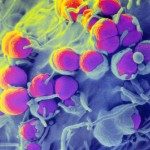Lien vers Pubmed [PMID] – 9770520
Proc. Natl. Acad. Sci. U.S.A. 1998 Oct;95(21):12532-7
Bordetella pertussis secretes a calmodulin-activated adenylate cyclase toxin, CyaA, that is able to deliver its N-terminal catalytic domain (400-aa residues) into the cytosol of eukaryotic target cells, directly through the cytoplasmic membrane. We have previously shown that CyaA can be used as a vehicle to deliver T cell epitopes, inserted within the catalytic domain of the toxin, into antigen-presenting cells and can trigger specific class I-restricted CD8(+) cytotoxic T cell responses in vivo. Here, we constructed a series of recombinant toxins harboring at the same insertion site various peptide sequences of 11-25 amino acids, corresponding to defined CD8(+) T cell epitopes and differing in the charge of the inserted sequence. We show that inserted peptide sequences containing net negative charges (-1 or -2) decreased or completely blocked (charge of -4) the internalization of the toxin into target cells in vitro and abolished the induction of cytotoxic T cell responses in vivo. The blocking of translocation due to the inserted acidic sequences can be relieved by appropriate mutations in the flanking region of CyaA that counterbalance the inserted charges. Our data indicate that (i) the electrostatic charge of the peptides inserted within the catalytic domain of CyaA is critical for its translocation into eukaryotic cells and (ii) the delivery of T cell epitopes into the cytosol of antigen-presenting cells by recombinant CyaA toxins is essential for the in vivo stimulation of specific cytotoxic T cells. These findings will help to engineer improved recombinant CyaA vectors able to stimulate more efficiently cellular immunity.



